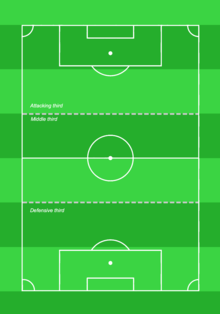
Team tactics as well as individual skills are integral for playing association football. In theory, association football is a very simple game, as illustrated by Kevin Keegan's namely assertion that his tactics for winning a match were to "score more goals than the opposition". Tactical prowess within the sport is nonetheless a craftsmanship of its own, and one of the reasons why managers are paid well on the elite level. Well-organised and ready teams are often seen beating teams with more skillful players on paper. Manuals and books generally cover not only individual skills but tactics as well.[2][3]
Association football teams consist of ten outfield players and one goalkeeper, which makes passing an integral part of game strategy, and is taught to players from a young age. Other skills taught to players on an individual level are dribbling, heading the ball and ball control for receiving the ball. Other skills that are taught individually are jockeying for defenders, and shot stopping for goalkeepers. In terms of complexity, lower levels of the game such as youth leagues, amateur leagues and semi-professional leagues primarily focus on the fundamentals of the game, whereas higher levels of the game – as it regards to professional football teams – will increase complexity and level of detail in strategy of the game.[4][5]
- ^ Tucker, Wayne; Mellalieu, D. Stephen; James, Nic; Taylor, B. Joseph (2005). "Game Location Effects in Professional Soccer: A Case Study". International Journal of Performance Analysis in Sport. 5 (2). Taylor & Francis Online: 23–35. doi:10.1080/24748668.2005.11868325. S2CID 141284292. Retrieved 8 January 2023.
- ^ Ken., Jones (1979). Soccer skills & tactics. Welton, Pat. Sydney: Books for Pleasure. ISBN 9780729601818. OCLC 27536554.
- ^ "Coaching Convention: 2020 edition" (PDF). UEFA. Retrieved 23 June 2022.
- ^ Football/Soccer: History and Tactics. McFarland & Company Inc. 2011. ISBN 978-0-7864-4784-8.
- ^ Rahimian, Pegah; Toka, Laszlo (2022). "Inferring the Strategy of Offensive and Defensive Play in Soccer with Inverse Reinforcement Learning". Machine Learning and Data Mining for Sports Analytics. Communications in Computer and Information Science. Vol. 1571. Springer Link. pp. 26–38. doi:10.1007/978-3-031-02044-5_3. ISBN 978-3-031-02043-8.